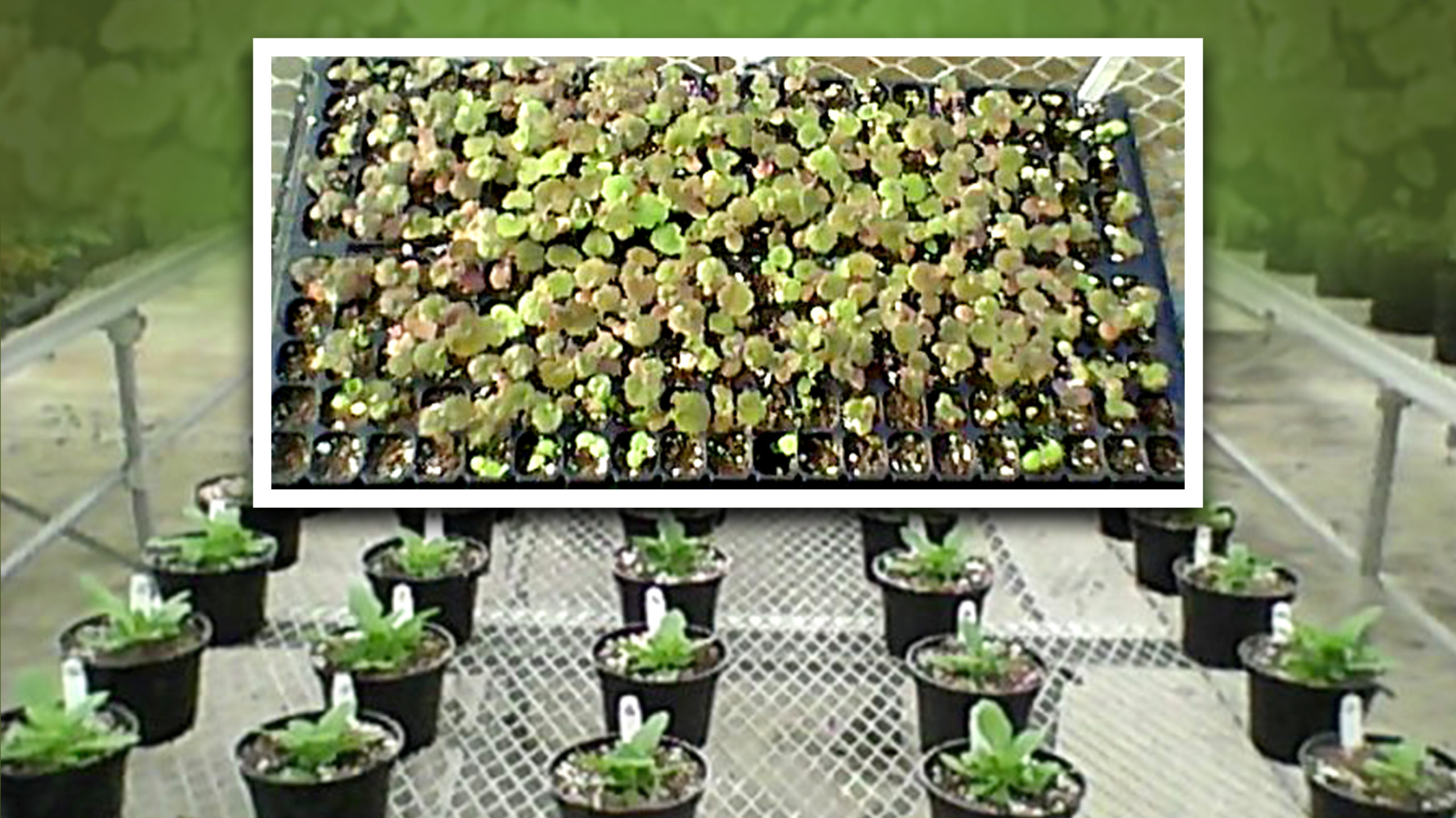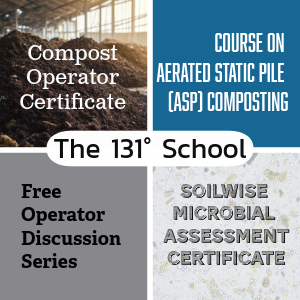José M. Álvarez de la Puente
Much of the work on reducing greenhouse gas emissions and carbon (C) sequestration using biotic strategies has been conducted in row crops and forest systems. Little research has focused on contributions from sectors of the specialty crop industry such as ornamental horticulture. In fact, there is much uncertainty regarding best practices for lowering greenhouse gas (GHG) emissions and increasing carbon storage in the ornamental horticulture industry. This is an area to be studied (Marble et al..2012).
Peat moss is the most used soilless substrate in production of containerized plants. Globally, over 11 million tons of peat are used annually in horticulture (U.S. Dept. of Interior, 2013) due to its consistent physical characteristics and high nutrient exchange capacity. Environmental concerns about draining peat bogs and the fact that peatland mining eliminates the carbon sink function of the peatland (Waddington et al.,2002) have spurred research on complementary products that can be added to peat, including different kinds of compost. More recently, biochar has also been considered as a possible perlite and peat replacement in horticulture (Bedussi et al., 2015). Similarly there is a synergy between compost and biochar when using them together as soil amendment (Alvarez et al., 2018b).
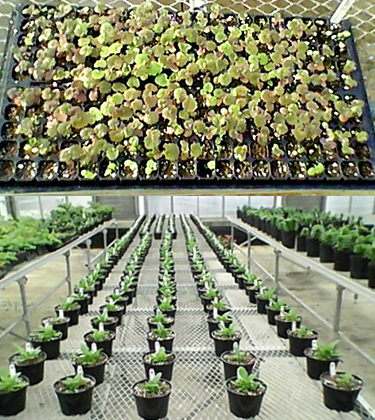
Plants were first grown in a plastic tray of 200 plugs (top) and then transplanted to 800 ml containers and placed on tables in the greenhouse in random 5 block designs (above).
Research Trials
The author conducted three different comparative greenhouse studies to assess the suitability of biochar (B) and vermicompost (V) as partial substitutes for peat-based growing media for ornamental plant production. Vermicompost was chosen because of its nutrient quality and lack of heavy metals. The first study, discussed in this article (Part I), focused on the possibility of growing commercial quality containerized ornamental bedding plants (e.g., petunia and geranium) using 24 different biochar/vermicompost mixes.
In the second study, the five best performing growing media were selected and the physiological plant responses when growing those species with our selected mixtures were verified. In the final study, leachates from the containers were analyzed to verify if fewer nutrients were lost by irrigation when growing those species with the selected mixes. The latter two studies will be discussed in Part II of this article.
Viability As Growing Media Replacement
A peer reviewed article on the first study was published in the Journal of Applied Horticulture in 2017 (Alvarez et al., 2017). The goal was to assess the viability of vermicompost and biochar as growing media replacement for ornamental plant production.
Materials and Mixes: Both biochar and vermicomposts are commercially available, produced from raw materials that exist in most regions, and that are capable of being recycled as partial substitutes for peat. The biochar for this study (Soil Reef Pure 02, Biochar Solutions Inc.) was produced by pyrolysis of Pinus monticola wood at high temperature (600°-800°C). The vermicompost (Black Diamond Vermicompost) was made from dairy manure solids. The raw material was precomposted for two weeks in an aerated system, then processed by vermicomposting for 70 to 80 days. Twenty-three blends of biochar at a volume fraction of 0, 4, 8, and 12%, and vermicompost at 0, 10, 20, 30, 40, and 50%, were compared to a baseline peat substrate (S) as control in the cultivation of geranium (Pelargonium peltatum) and petunia (Petunia hybrida) (Table 1).
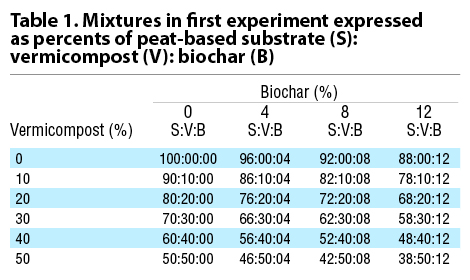 Design: Trials were performed at the Ohio State University Horticulture Department greenhouses. A random 5 block design was used for each species: one set of 2 species x 24 treatments x 5 blocks = 240 containers of 800 ml each. The steps were as follows:
Design: Trials were performed at the Ohio State University Horticulture Department greenhouses. A random 5 block design was used for each species: one set of 2 species x 24 treatments x 5 blocks = 240 containers of 800 ml each. The steps were as follows:
1) Seedlings were produced on 200 plugs (21.8 cm3) plastic germination tray for 40 days under average 54% moisture and at 24°C in a greenhouse with a microsprinkler irrigation system.
2) Seedlings were transferred to 800 ml plastic containers and placed on 15 m2 tables per species at a greenhouse with an average 20°C temperature and 29% humidity. Containers were watered manually as needed.
3) The growing period was 8 weeks for Petunia and 11 weeks for Pelargonium.
Measurements: Substrates were characterized for physical properties following the North Carolina State University porometers methodology. Chemical properties were measured after water extract at a volume ratio 1:6. The plants’ commercial quality was evaluated measuring plant growth by shoot dry weight and flower production. For Petunias, only the number of flowers was counted. For Pelargonium, both the number of open inflorescences and inflorescence buds number were counted.
Nutrient concentrations were assessed in leaves after samples were digested in nitric acid. Phosphorus, potassium, calcium, magnesium, sulfur, iron, manganese, boron, copper, zinc, and sodium were determined. Total nitrogen was also determined by spectrophotometry in a flow auto analyzer after Kjeldahl digestion. Nutrients in substrates were measured before and after cultivation using an ICP-OES Plasma Spectrometer after extraction, and were expressed on a volume basis.
Results: The substrates’ physical properties, bulk density, water holding capacity, total porosity and air space were determined. The general trend was a slight but significant decrease in air space as the vermicompost ratio increased in the mixture, and similarly a slight bulk density increase as the percent of vermicompost increased in the mixture. The tendency was a significant increase of pH and electrical conductivity when the percent of vermicompost increased. The pH raised from 5.2 in control to 6.6 with 50% vermicompost in the mixture.
Mixtures with low to medium levels of vermicompost (10-30%) and high biochar level (8–12%) in Petunia and Pelargonium induced more growth and flower production than that of the control. In terms of leaf nutrients, phosphorus, potassium, calcium, magnesium and sulfur contents increased with the increase in volume fraction of vermicompost.
Carbon Storage In Soil After Transplanting
Some studies (Steiner & Harttung, 2014) have shown reductions in GHG emissions when biochar is used as peat substitute for growing plants. Biochar decomposes slowly (Kuzyakov et al., 2009) and can be stored for relatively long periods. Vermicompost, on the other hand, has a faster decomposition rate, so no significant C storage in soil is expected by vermicompost when compared to biochar. This is why carbon storage was only calculated based on the biochar potential effect.
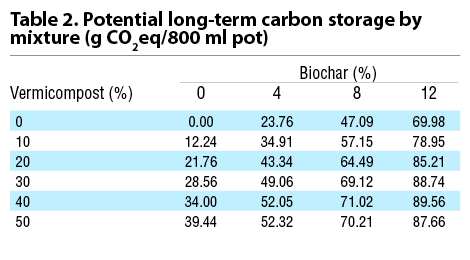 However, peat volume substituted by vermicompost has a CO2 sink role and it has been included in our calculation. Considering the mix 68:20:12 (S:V:B, volume basis) and its obtained bulk density measurement, it would be possible to store up to 85.21 grams of CO2e per 800 ml container for long periods of time — first in the plant´s growing container and then in the soil after transplanting (Table 2).
However, peat volume substituted by vermicompost has a CO2 sink role and it has been included in our calculation. Considering the mix 68:20:12 (S:V:B, volume basis) and its obtained bulk density measurement, it would be possible to store up to 85.21 grams of CO2e per 800 ml container for long periods of time — first in the plant´s growing container and then in the soil after transplanting (Table 2).
José M. Álvarez de la Puente is an independent scientific advisor and has been a BioCycle contributor on urban and agroindustrial compost. He holds a PhD in Industrial and Environmental Science and Technology from the University of Huelva, Spain. His PhD dissertation was defended in June 2019 at the Carbon Sequestration and Management Center of the Ohio State University as a visiting scholar.


